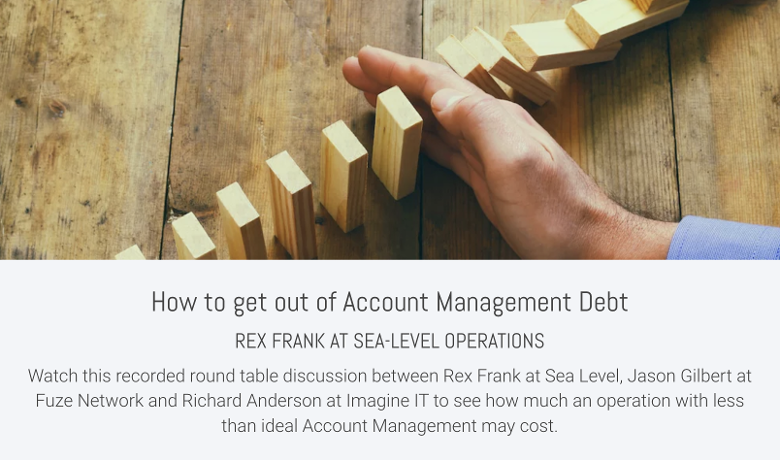
We asked last week during our webinar with Sea-Level Operations: What are the symptoms of Account Management debt? Low perceived value, communication breakdown, and churn were included in 100% of the responses. Most interestingly 77% of the time churn was mentioned without prompting. During the session we analyzed this situation and identified the crucial methods to prevent potential churn. We are going to highlight the 5 major activities Account Managers can do to accomplish this.
STRUCTURE, MANAGE AND AUTOMATE YOUR ACCOUNT MANAGEMENT AND VCIO PROCESESS
1. Creating a Business Context around Services
The first priority for Account Managers would be to connect the IT services to their business goals. This can happen with IT Strategy planning meetings when the major focus is on the client’s business goals, issues and challenges. Properly applied to their IT Roadmap these findings can be quite effective.
Most MSPs make the mistake of proactively creating and presenting these plans to the clients without actually interviewing them. This is like a doctor writing prescriptions without a diagnostic exam. It is not enough that the MSP knows what to do and what needs doing. The client needs to feel understood! That’s what makes Strategy Workshops critical.
Churn Prevention Factor: 10 out of 10 by making you a strategic partner rather than a technical vendor.
2. Value Demonstration by Service Definitions
MSPs offer very complex and technical services bundled into specific packages. Back when the value proposition of an MSP was “peace of mind” for the client and the client had problems, the bundled service was an easy sell. Of course now that MSPs make their clients complacent and “problem-free” the pains are gone and clients are second-guessing the value of the given services.
Detailed Service Definitions and regular mandatory reviews help to remind clients that problems seems distant BECAUSE of the huge amount of work, professionalism, and services delivered. These Service Definitions though should not be phrased technically, but in a way that a business owner understands that one key point: they are paying fair wages for these services.
Churn Prevention Factor: 8 out of 10 by getting everybody on the same page regarding how much professional work goes into having a “hassle-free IT” operation.
3. Value Demonstration by Excellence Models
The other communication issue with clients is a symptom of the ever-changing technology landscape and the client’s obligation to make their IT investments aligned with newly required quality. This idea is lost easily without being able to see the big picture. Asking to fund a firewall upgrade will definitely be viewed as an “unnecessary expense”.
Excellence models and scores can help define what “good” looks like and how “excellent” looks better in any given area. The MSP can create an excellence model for Office 365 / IT Infrastructure / Cybersecurity / Applications and so on. The excellence model can be reviewed through an internal audit where the MSP goes through the relevant criteria. The result is presented to the client as a score, which is easily referenced and compared over time.
Now going back to the firewall issue. By auditing the client and showing 80-90% “green” scores all over the place you’ll instill confidence that their MSP is delivering value. On the other hand showing a potential “red” score with 40% will highlight a bottleneck that can be remedied with an updated firewall. Now the expense is not a waste but a conscious and wise decision by the executive to turn that red light green.
Churn Prevention Factor: 8 out of 10 by illuminating every issue from a big picture perspective.
4. Consistency by Proactive rather than Reactive Meetings
I learned the big difference between being proactive and reactive from Steven Covey. Being reactive is the easy and mentally lazy default approach. Like if the phone rings we pick up, if an email arrives we open. Proactive things are often not urgent but important and we have to act upon them. Reading a book is proactive as the book never rings and never notifies our inbox. Reading a book is never urgent but can be vitally important. The same can be said about quality time with clients.
Clients will initiate calls to which they expect you to react. That’s easy, but it’s also easy to neglect to proactively prepare an agenda, generate a report and spark conversation. Consistency means you put the important ahead of the urgent and you carve out the capacity and time to regularly meet with clients regardless of current issues. Bringing topics to those meetings will help you avoid getting mired in operational items and focus instead on their business objectives as you direct rather than respond to topics. Further if clients don’t see consistency within your interactions they’ll be hard pressed to believe in your service delivery consistency either.
Churn Prevention Factor: 7 out of 10 by demonstrating consistency with proactive meetings.
5. Contact All Stakeholders As MSP’s
QBRs are full of tactical elements such as ticket reviews, service delivery issues, upcoming technology updates and so on, and key stakeholders are often absent. Business owners and executives are not interested in the details, but without having a platform to meet with them the MSP will lose communication lines with the key decision-makers.
This is why forward-thinking MSPs have been designing meetings just for executives. Office Productivity Audits, IT Leadership Workshops or Application Implementation Projects are ideal for the decision-maker audience. IF an MSP cannot separate the tactical from the strategic the majority of the conversation will be reactive/tactical rather than proactive/strategic.
Churn Prevention Factor: 7 out of 10 by demonstrating consistency with proactive meetings.
Conclusion:
You do not have to do everything immediately. Getting out of the Account Management Debt is a process. But this process also has quick wins. See where you are the weakest and fix those first.
I strongly recommend the webinar we made with Rex, Rich, Jason together walking through these topics.


